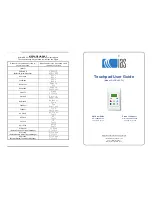
PV-ezRack SolarTripod (double and single) Installation guide V2
Page 3 of 15
11/20 Duerdin St
Tel: +61 3 9017 6688
Clayton VIC 3168, Australia
Fax: +61 3 9017 6668
www.clenergy.com.au
Email: [email protected]
2
Planning
This document is designed to support installations using SolarTripod, manufactured
by Clenergy (Xiamen) Technology Co., Ltd. Follow the six steps below and the
installation instructions section to install Clenergy PV-ezRack SolarTripod in
compliance with the AS/NZS1170.2-2011 Amdt 3 2013
.
Before proceeding, note the following:
This document addresses only wind loads on the assumption that wind
produces the maximum load factor affecting an installation. Verify that
other local factors, such as snow loads and earth quake effects, do not
exceed the wind loads. Give precedence to any factor that does. Wind
loads are considered to act on the entire projected area, or may be
perpendicular to any surface.
The roof on which the SolarTripod will be installed must have the capacity
to resist the combined Design Dead Load and Live Load per footing.
Installation Tools
6mm Allen Key;
14mm Open end wrench;
Power Tool(s);
5m Tapeline;
Spring Thread.
2.1
Determine the wind region of your installation site
Region Definition:
Wind regions are pre defined for all of Australia by Australian Standard 1170.
The Wind Region has nothing to do with surrounding topography or buildings.
• Most of Australia is designated Region A which indicates a Regional
Ultimate Basic Wind Velocity of 45msec.
• Some areas are designated Region B (57m/sec). Local authorities will
advise if this applies in your area.
• Region C areas (66m/sec) are generally referred to as cyclonic and are
generally limited to northern coastal areas. Most Region C zones end
100km inland.
• Region D (80m/sec) Australia's worst Cyclonic Region between
Carnarvon and Pardoo in Western Australia.

































